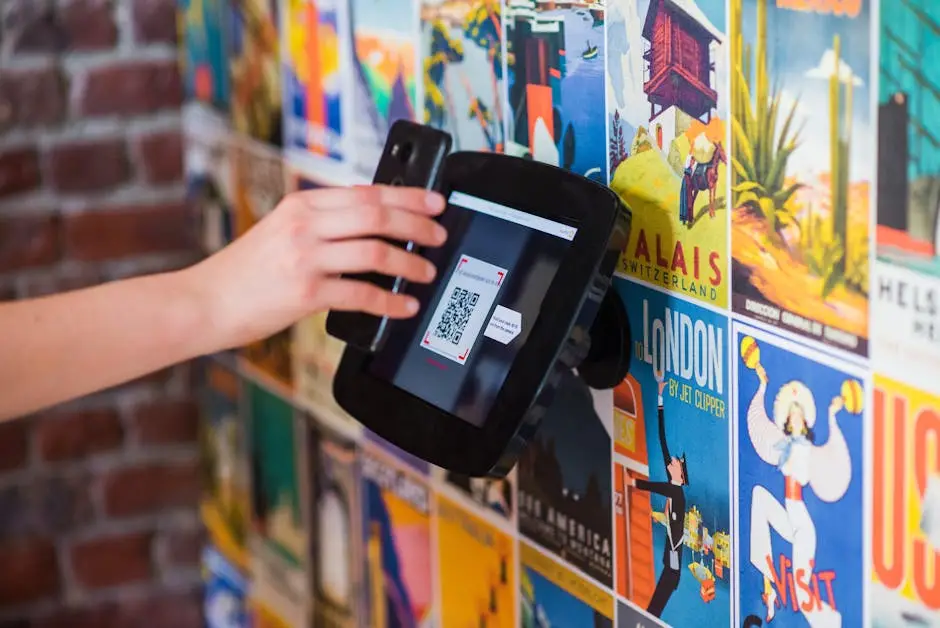Introduction: Why Tracking Print ROI is No Longer Optional
For decades, marketers treated print advertising like a leap of faith. You’d run an ad in a magazine or send out a direct mail campaign, cross your fingers, and hope for an uptick in business. In today’s data-driven world, however, hope is not a strategy. The pressure is on to justify every marketing dollar, and the once-daunting challenge of tracking print marketing ROI has finally been solved. Modern tools and simple strategies have bridged the gap between a physical ad and a digital action, making measurement not just possible but essential for smart budget allocation.
Understanding your print advertising effectiveness allows you to optimize your spend and prove the channel’s value. By gathering concrete data, you can see which designs, offers, and publications drive the most engagement. This guide will walk you through the exact methods needed to measure your print campaign accurately, turning your tangible marketing materials into highly measurable, performance-driving assets.
Section 1: Understanding the Fundamentals of Print ROI

Before we explore the specific tools for tracking, it’s essential to understand what you’re measuring. At its core, tracking print marketing ROI is about quantifying the return on your investment. The fundamental formula is simple: (Sales Growth from Campaign – Marketing Cost) / Marketing Cost. The ‘Marketing Cost’ is the easy part to tally; it includes design fees, printing expenses, and distribution costs like ad space or postage. The real challenge has always been isolating the ‘Sales Growth from Campaign.’ How can you be sure that a recent sales lift came from your magazine ad and not another channel? This is where modern tracking strategies become invaluable. To accurately calculate print ad ROI, you must create a clear, measurable path from your physical ad to a customer action. This transforms vague correlations into hard data, giving you the concrete print marketing metrics needed to prove value.
What is Return on Investment (ROI)?
Return on Investment (ROI) is a fundamental performance metric that measures the profitability of a specific marketing initiative relative to its cost. It answers the simple but critical question: “For every dollar we spent, how much did we get back?” In the context of print, a positive ROI means the revenue generated directly from your ad surpassed the costs of design, printing, and distribution. Accurately knowing this figure is the first step to truly understanding your print advertising effectiveness and justifying future budgets.
The Core Formula: (Sales Growth – Marketing Cost) / Marketing Cost
Let’s break down this crucial equation. ‘Marketing Cost’ is your total investment—it includes everything from graphic design and printing to the price of the ad space or postage for a direct mail campaign. The ‘Sales Growth’ is the revenue generated *specifically* from that print ad; this is the key figure that modern tracking helps you isolate. By subtracting the cost from the attributable growth and then dividing by that same cost, you can accurately calculate print ad ROI. This transforms a vague guess into a powerful, data-backed performance metric.
Key Metrics to Track Beyond Direct Sales (e.g., Website Visits, Phone Inquiries, Brand Awareness)
While the ROI formula centers on sales, a comprehensive approach to tracking print marketing ROI looks at the entire customer journey. Not every reader will buy immediately. Other crucial print marketing metrics provide a fuller picture of engagement: unique website visits, lead form submissions, or inquiries made through a dedicated tracking phone number. These actions signal strong interest and build your sales pipeline. Measuring these intermediate conversions is vital for truly understanding your campaign’s full impact beyond just the initial sale.
Section 2: Core Methods for Tracking Print Marketing Campaigns

Now that we understand the ‘what’ and ‘why’ of tracking, let’s dive into the ‘how’. The foundation of successfully tracking print marketing ROI is creating a clear, digital bridge from your physical material to a measurable online action. This eliminates guesswork and provides concrete data. The most effective strategies involve giving your audience a unique pathway to follow, directly attributing their engagement to a specific campaign. These core methods include creating custom URLs for print that lead to dedicated landing pages, leveraging scannable QR codes for tracking engagement, offering unique promo codes for print ads, and utilizing dedicated tracking phone numbers for call-in responses. Each of these tools acts as a digital fingerprint, allowing you to accurately measure your print campaign and see precisely which ads are driving results, a crucial step for calculating everything from magazine ad performance to direct mail ROI.
Method 1: QR Codes – The Digital Bridge
Once a novelty, QR (Quick Response) codes are now the ultimate digital bridge, instantly connecting a physical ad to an online experience. By placing a unique QR code on your flyer, poster, or magazine ad, you create a frictionless path for your audience. A simple scan with a smartphone camera can lead them to a specific landing page, video, or app download. Using QR codes for tracking provides a direct, quantifiable metric for engagement, allowing you to easily measure your print campaign’s reach and user interest.
How to Create and Implement QR Codes
Creating a trackable QR code is simple. Use one of the many online QR code generators and link it to a unique, campaign-specific landing page—never your generic homepage. This is the most critical step for attribution. The destination URL should be trackable (e.g., using UTM parameters) so you can isolate scan data in your analytics platform. Before a full production run, always print and test your QR code to ensure it scans correctly. This process makes using QR codes for tracking a reliable way to measure engagement.
Best Practices for Placement and Calls-to-Action
A QR code’s effectiveness hinges on its context. For maximum engagement, place the code in a prominent spot with ample white space—a “quiet zone”—to ensure it scans easily. Crucially, you must pair it with a strong, benefit-driven Call-to-Action (CTA). Vague instructions like “Scan Me” are ineffective. Instead, use compelling commands like “Scan for an Exclusive Discount” or “Scan to Watch the Demo.” This simple practice transforms the QR code from a passive design element into an active tool, boosting scan rates and improving how you measure print campaign interaction.
Method 2: Custom URLs and Landing Pages
Using custom URLs for print ads is a classic and highly effective method for tracking print marketing ROI. Instead of your homepage, you feature a unique, memorable URL (e.g., YourSite.com/Offer22) on your direct mail piece or magazine ad. Because this URL is exclusive to the campaign, any traffic it receives can be directly attributed. This isolates engagement, allowing you to accurately measure the print campaign and providing the clear data needed to calculate direct mail ROI.
Using Vanity URLs or PURLs (Personalized URLs)
Take your use of custom URLs for print to the next level with vanity URLs or PURLs (Personalized URLs). A vanity URL is a short, memorable link (e.g., YourBrand.com/SpringSale) that’s easy to type. A PURL is even more powerful for campaigns like direct mail, personalizing the link with the recipient’s name (e.g., YourBrand.com/Jane-Doe). This personal touch dramatically boosts engagement, providing highly granular data to measure individual responses and accurately calculate direct mail ROI.
Designing Landing Pages for Conversion
The effectiveness of your custom URL hinges on its destination. Your landing page must be specifically designed for conversion with one clear goal. Ensure the headline, visuals, and offer perfectly match the print ad to create a seamless user experience. Remove site navigation and other distractions to focus attention on a single call-to-action. This targeted design is crucial for maximizing conversions and providing the clean data needed to accurately calculate print ad ROI and justify your marketing spend.
Method 3: Unique Promotion & Coupon Codes
Using unique promo codes for print ads is a straightforward yet powerful way to connect offline advertising to online or in-store sales. By creating a specific code (e.g., “MAG25”) for each campaign, you can track every redemption. This gives you concrete data on which ads are driving purchases, making it a cornerstone for accurately tracking print marketing ROI. This direct attribution allows you to clearly measure print campaign success and gauge the true print advertising effectiveness of different channels.
Tracking Redemptions Both Online and In-Store
The true power of unique promo codes for print ads is realized when you track redemptions across all sales channels. For online purchases, your e-commerce platform can automatically log every code used at checkout. For in-store sales, your Point-of-Sale (POS) system must be configured to accept and report on these specific codes. By combining data from both your digital and physical storefronts, you create a comprehensive view of customer response, which is essential to accurately measure print campaign success and overall print advertising effectiveness.
Segmenting Offers to Test Different Creatives
Elevate your strategy by using unique codes to A/B test your creative elements. Assign different promo codes for print ads—for instance, “SAVEBIG” for an ad with one headline and “GET20” for an ad with another—to see which performs better. This powerful segmentation provides invaluable data, revealing which message or design truly resonates. This is a critical tactic for refining your campaigns, boosting print advertising effectiveness, and ensuring every dollar spent is optimized for the highest possible return.
Method 4: Dedicated & Trackable Phone Numbers
For businesses where a phone call is a primary conversion, using dedicated tracking phone numbers is a game-changer. By assigning a unique phone number exclusively to a specific print ad or direct mail campaign, you can directly attribute every incoming call. This method provides unambiguous data on which ads are prompting customers to take action. It is an essential tactic for any business that relies on phone leads, allowing you to accurately measure print campaign performance and gather vital print marketing metrics.
How Call Tracking Software Works
Call tracking software makes using dedicated tracking phone numbers simple. These services provide unique, local, or toll-free numbers that you assign to specific print materials. When a customer dials one of these numbers, the software automatically forwards the call to your main business line while simultaneously logging the original source. It captures crucial print marketing metrics like call duration, time of day, and even call recordings for quality assurance. This allows you to directly measure print campaign success and attribute phone leads accurately.
Attributing Phone Leads Directly to Print Ads
The true power of dedicated tracking phone numbers lies in the certainty they provide. When your call tracking dashboard flags an incoming call from the unique number you placed in a magazine ad, you know definitively that ad generated the lead. This completely removes the guesswork from asking customers, “How did you hear about us?” This direct attribution provides the clean, reliable print marketing metrics you need to measure the real-world impact of your creative and accurately calculate print ad ROI.
Method 5: The Direct Question – “How Did You Hear About Us?”
While less technologically advanced, the classic question—“How did you hear about us?”—can still provide valuable insights. By training sales staff to ask this at the point of sale or including it as a field on your contact forms, you can gather useful anecdotal data. However, this method is not foolproof; it relies on customer memory and inconsistent staff execution. For this reason, it should be used as a supplementary tool rather than the primary method for accurately tracking print marketing ROI.
Training Your Team to Ask Customers
To make the “How did you hear about us?” method effective, consistent team training is non-negotiable. Instruct your sales and customer service staff on the importance of this question—it directly helps justify marketing spend. Provide a simple script to ensure consistency and a clear process for logging responses, whether in your CRM or a shared spreadsheet. By making this a standard part of every new customer interaction, you can gather valuable anecdotal print marketing metrics to supplement your more precise digital tracking methods.
Integrating the Question into Forms and Surveys
Beyond face-to-face interactions, you can systematically collect this data by adding the “How did you hear about us?” question to your digital touchpoints. Integrate this field into your website’s contact forms, checkout pages, or post-purchase email surveys. For cleaner and more reliable data, use a dropdown menu with pre-defined options (e.g., Magazine Ad, Postcard, Friend/Referral) instead of an open text box. This approach helps capture valuable supplementary print marketing metrics from users who may not interact directly with your sales team.
Section 3: Analyzing Your Data and Optimizing for Success

Once your campaigns are live and your tracking methods are in place, the data will start to roll in. This is where the real work of tracking print marketing ROI begins: analysis and optimization. Your goal is to consolidate all the disparate print marketing metrics into a single view. Pull the website traffic data from your custom URLs and QR codes in Google Analytics, the call logs from your dedicated tracking phone numbers, and the redemption reports from your e-commerce or POS system. By comparing these results, you can clearly see which campaigns are performing best. This analysis allows you to accurately calculate print ad ROI for each initiative and, more importantly, make data-driven decisions. You can now confidently re-invest in successful strategies and refine or eliminate underperforming ones, continuously improving your print advertising effectiveness with each new campaign.
How to Consolidate Data from Multiple Tracking Sources
The simplest way to consolidate your data is by creating a central dashboard or a master spreadsheet. For each print campaign, create a row and dedicate columns to your key print marketing metrics: website sessions from custom URLs, QR code scans, promo code redemptions, and calls from your trackable numbers. This unified view allows you to directly compare the performance of different ads side-by-side. By pulling these disparate numbers into one place, you can see the full picture of engagement and accurately measure print campaign effectiveness.
A/B testing Your Print Materials (Headlines, Offers, Designs)
With your consolidated data, you can begin optimizing through A/B testing. Create two versions of an ad, changing just one element—like the headline, offer, or image. Assign a unique tracking tool (e.g., promo code “SALE20” vs. “SAVE20”) to each version. This allows you to directly measure print campaign performance between the two variants. This data-driven approach is how you systematically improve print advertising effectiveness, identifying exactly what resonates with your audience and maximizing your return on future ad spends.
Using Your Insights to Refine Future Campaigns
The insights gained from tracking are not just historical data; they are a roadmap for future success. Use your findings to double down on what works. If a specific offer generated the highest direct mail ROI, make it a cornerstone of your next campaign. Did a certain creative drive more QR code scans? Use that visual style again. This iterative process of tracking, analyzing, and refining is the key to maximizing the return on every dollar and continuously improving your print advertising effectiveness.
Conclusion: Making Print a Measurable and Powerful Marketing Channel
The era of treating print advertising as a leap of faith is officially over. By systematically applying the methods detailed in this guide—leveraging QR codes, creating custom URLs, using unique promo codes, and implementing trackable phone numbers—you can build a solid bridge between your physical materials and digital engagement. The process of tracking print marketing ROI is no longer an insurmountable challenge; it’s a strategic necessity that provides clear, actionable data. This empowers you to accurately measure your print campaign, justify your budget with hard numbers, and continuously improve your print advertising effectiveness. By moving from guesswork to a data-driven strategy, you can confidently invest in print as a powerful, measurable, and highly profitable component of your overall marketing mix, ensuring every dollar is optimized for maximum impact.



